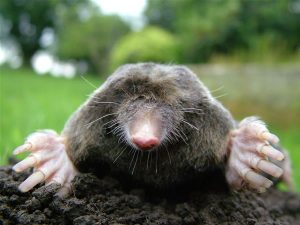Mole and Vole Removal and how you get rid of these lawn damaging varmints.

 They have similar sounding names and cause havoc in your yard. Other than that voles and moles have little in common. Moles may be be better known, but it’s voles that cause much of the damage blamed on moles.
They have similar sounding names and cause havoc in your yard. Other than that voles and moles have little in common. Moles may be be better known, but it’s voles that cause much of the damage blamed on moles.
It’s important to know which rodent you have because mole control and vole control depend on going after the right mammal.
The Difference
The biggest difference between a mole and vole is the type of damage. Moles eat insects and worms. Their primary diet is earthworms with a few grubs and insects tossed in as appetizers. They don’t eat plants, and so their landscape carnage is really the incidental damage of tunnels and runways dug in lawns while on the never-ending search for more worms.
Voles are plant-eaters. They feed on grass and perennial-flower roots. They eat seeds and bulbs, especially in winter when other foods are scarce. They will girdle the bark off trees and shrubs. Meadow voles also make networks of surface tunnels across the lawn under the snow cover of winter when they venture out into open spaces that they’d avoid in the growing season.
Moles are seldom seen because they live and feed underground. They’re gray to dark brown in color, about 6 to 7 inches long and distinguishable by their long noses and paddled, webbed front feet – perfect for tunnel excavation. They have no visible ears either. Those paddled front paws allow moles to dig tunnels at a rate of 1 foot per minute.
Being voracious feeders that eat quantities nearly equal to their body weight every day, moles are constantly tunneling in search of meals.
Voles are rodents that look much like mice, only with shorter tails. They’re dark brown in color, about 5 inches in length and have eyes and ears that you can readily notice. There are several different species of voles in North America – some that do most of their damage above ground (i.e. meadow voles) and some that do more insidious root- and bark-chewing from underground (i.e. pine voles).
Voles are prolific reproducers that can quickly colonize an area. To make up for a short life span of 16 months or less, voles can go from impregnation to baby-delivery in 21 days – cranking out three to six young at a time and up to 30 offspring per year. Because voles reproduce quickly, eat so many things and are pretty good at staying out of sight, they can do a lot of damage before you ever figure out what hit you.
Clues are surface tunnels in mulch and along walls as well as golfball-sized holes.
How to control moles
Determine whether you’re mad enough to kill them or satisfied with just trying to relocate them off the lawn.
 Killing moles is normally the most effective long-term control. Some say it’s the only way you’re really going to solve the problem. Killing moles can be done either by traps or baits. Both scissor-type and harpoon-type traps are used. To use these, locate active runs by tamping down tunnels and then watching to see where the tunnels are raised back up a day or two later. These are good spots to insert traps. When the mole comes swimming through, it trips the mechanism that administers the fatal blow.
Killing moles is normally the most effective long-term control. Some say it’s the only way you’re really going to solve the problem. Killing moles can be done either by traps or baits. Both scissor-type and harpoon-type traps are used. To use these, locate active runs by tamping down tunnels and then watching to see where the tunnels are raised back up a day or two later. These are good spots to insert traps. When the mole comes swimming through, it trips the mechanism that administers the fatal blow.- The kinder, gentler trap approach is to sink a glass jar in the floor of one of the active runs. When the mole comes by, it drops into the jar and can’t climb up the slippery sides. Havahart or similar cage traps also can be used in runs to capture moles instead of kill them. The live animal then can be relocated to a site where it won’t cause trouble.
- Numerous poison and anticoagulant baits also are available, but these must be applied with extreme caution so they don’t harm unintended targets or run off into waterways. It’s usually best to hire a pro if you go this route. Pros have access to more effective ingredients that homeowners can’t buy.
- Another method of mole control is to repel them. The most widely used repellent is castor oil – whether it’s in a commercial product such as Mole-Med or mixed as a homemade treatment. To make your own safe mole repellent at home, combine 6 ounces of castor oil and 2 tablespoons of liquid detergent in 1 gallon of water. Mix well. Then dilute to spray on the entire lawn at a rate of 1 ounce per gallon of water applied per each 300 square feet of lawn. This may work for awhile, but when the scent goes away, Mr. Mole may well move back to familiar and already-mined territory.
- Regulating at least some of a mole’s food supply may help a little. Since moles are fond of beetle grubs in the lawn (one of their benefits to homeowners), you may be able to discourage them by controlling grubs. An annual lawn-grub treatment in June or July of Lebanon Fertilizer with Merit or an application of bacterial-based Milky Spore disease granules can help on that front. If nothing else, you’ve addressed possible lawn damage from the grubs’ feeding.
- However, since moles primarily feed on earthworms, killing every last grub won’t solve the mole problem so long as there are still plenty of worms. Finally, homeowners have devised all sorts of gizmos and techniques that some swear cured their mole invasions. None have been backed by scientific research, but if you want to take a crack at any of these anecdotal measures, here you go:
* Sonic chasers. Battery-powered spikes or similar gadgets that vibrate underground.
* Sunken soda bottles with the open tops just above ground. The wind supposedly creates vibrations similar to sonic chasers.
* Gas cartridges lit and inserted into runs.
* Flooding the burrows with water.
* Mothballs in active tunnels.
* Setting out chewing gum, which supposedly clogs up their intestines.
* Dumping used kitty litter or glass fragments down their burrows.
* Inserting lava rocks soaked in onion and garlic solution into burrows.
How to control voles
 One of the best ways to control voles is to send a cat out on patrol. Cats love hunting for rodents, and they’re often so proud of their conquests that they’ll bring dead prey into the house just to show you what good hunters they are.
One of the best ways to control voles is to send a cat out on patrol. Cats love hunting for rodents, and they’re often so proud of their conquests that they’ll bring dead prey into the house just to show you what good hunters they are.- If you like the general idea of nature vs nature but not the dead-vole-in-the-house part, encourage other natural vole predators – namely hawks and owls. Planting more trees on your lot is one good move. Or you could add a bird perch or two by erecting a 15-foot pole with a 1- to 2-inch perch at the top. Snakes also are prime vole predators.
- Snap traps manufactured mainly for mice also are effective at catching voles. A 50-50 mix of peanut butter and oatmeal is a favorite bait, and so are small apple slices. For maximum effect, place traps along active runs and disguise them with an inverted box and/or leaves and grasses (with the vegetation out of the way enough that it doesn’t impair the traps). Some people allow voles to take the bait for a few days before actually setting the traps.
- If you don’t want to kill the voles, use the same baits in a Havahart or similar cage trap. When the vole trips the plate, the doors close. Then you can relocate voles – preferably at least a half mile away in a place that won’t cause damage for someone else.
- To discourage voles from tunneling into beds, try digging sharp materials into your soil. Commercial products such as Permatill and Soil Perfector are ideal for this purpose, and even coarse gravel may do the trick. About 10 percent gravel to 90 percent soil is enough to make uncomfortable tunneling for a vole. In existing beds, channels of this material can be dug a few inches vertically into the perimeter – creating a kind of gravelly moat around a flower bed.
- In bulb beds, sheets of chicken wire can be laid over the top of the beds to prevent voles and other rodents from burrowing down in. Or the bulbs can be completely surrounded by wire to protect them from all angles. Bulb shoots will poke through the openings. A variety of repellents such as Ro-Pel, Plantskyyd, Liquid Fence, hot-pepper sauce, the fungicide thiram and more are effective at keeping voles from eating live plants and bulbs. The main downside is that these need to be reapplied periodically and after heavy rains.
- In a similar protective vein, young trees and shrubs can be saved from bark-gnawing by wrapping hardware cloth around the base of the trunks. Be sure to bury the screen 4 to 5 inches deep and go up the trunks at least 2 feet.
Some of the same anecdotal measures for moles also may help control voles. Or not. If not, professional pest-control companies can usually get things under control with a combination of baits and traps.
Good luck on your quest. Feel free to call us if you have any questions – (651) 646-6431.
Sharing is caring (please click icons below if you liked this page)